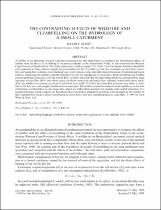 ResearchSpace
ResearchSpace
Contrasting effects of wildfire and clearfelling on the hydrology of a small catchment
JavaScript is disabled for your browser. Some features of this site may not work without it.
- ResearchSpace
- →
- Research Publications/Outputs
- →
- Journal Articles
- →
- View Item
| dc.contributor.author |
Scott, DF

|
|
| dc.date.accessioned | 2007-06-29T09:26:04Z | |
| dc.date.available | 2007-06-29T09:26:04Z | |
| dc.date.issued | 1997-05 | |
| dc.identifier.citation | Scott, DF. 1997. Contrasting effects of wildfire and clearfelling on the hydrology of a small catchment. Hydrological Processes, vol. 11(6), pp 543-555 | en |
| dc.identifier.issn | 0885-6087 | |
| dc.identifier.uri | http://hdl.handle.net/10204/802 | |
| dc.description | Copyright: 1997 John Wiley & Sons Ltd | en |
| dc.description.abstract | A wildfire in an afforested research catchment presented the rare opportunity to compare the hydrological effects of wildfire with the effects of clearfelling in the same catchment in the Jonkershoek Valley, in the south-western Western Cape Province of South Africa. The timber plantation, which occupies 57% of the 2 km(2) catchment, had been clearfelled and re-planted to Pinus radiata roughly five years before the fire. The effects of the two treatments on total flow, stormflow and quick-flow volumes, peak discharge and storm response ratio were determined by means of multiple regression analysis, employing the dummy variable method to test for the significance of treatments. Both clearfelling and wildfire caused significant increases in all the stream-flow variables analysed. But the clearfelling effect was dominated by large increases in total flow (96% over three years), of which storm-flow and quick-flow volumes formed only minor parts. After the wildfire, by contrast, increases in total flow were small (12%) but the storm flow increases were three- to fourfold in the first year and roughly double in the second year. The wildfire caused fire-induced water repellency in the soils which led to overland flow on mid-slope sites, where soil infiltrability normally far exceeds local rainfall intensities. It is argued that these results support the hypothesis that stream-flow generation processes were changed by the wildfire in that overland flow made a direct contribution to storm flows, but that clearfelling had no such effect. | en |
| dc.language.iso | en | en |
| dc.publisher | John Wiley & Sons Ltd | en |
| dc.subject | Clearfelling | en |
| dc.subject | Storm flow analysis | en |
| dc.subject | Stream flow generation | en |
| dc.subject | Water repellent soils | en |
| dc.subject | Wildfire | en |
| dc.subject | Water resources | en |
| dc.title | Contrasting effects of wildfire and clearfelling on the hydrology of a small catchment | en |
| dc.type | Article | en |
| dc.identifier.apacitation | Scott, D. (1997). Contrasting effects of wildfire and clearfelling on the hydrology of a small catchment. http://hdl.handle.net/10204/802 | en_ZA |
| dc.identifier.chicagocitation | Scott, DF "Contrasting effects of wildfire and clearfelling on the hydrology of a small catchment." (1997) http://hdl.handle.net/10204/802 | en_ZA |
| dc.identifier.vancouvercitation | Scott D. Contrasting effects of wildfire and clearfelling on the hydrology of a small catchment. 1997; http://hdl.handle.net/10204/802. | en_ZA |
| dc.identifier.ris | TY - Article AU - Scott, DF AB - A wildfire in an afforested research catchment presented the rare opportunity to compare the hydrological effects of wildfire with the effects of clearfelling in the same catchment in the Jonkershoek Valley, in the south-western Western Cape Province of South Africa. The timber plantation, which occupies 57% of the 2 km(2) catchment, had been clearfelled and re-planted to Pinus radiata roughly five years before the fire. The effects of the two treatments on total flow, stormflow and quick-flow volumes, peak discharge and storm response ratio were determined by means of multiple regression analysis, employing the dummy variable method to test for the significance of treatments. Both clearfelling and wildfire caused significant increases in all the stream-flow variables analysed. But the clearfelling effect was dominated by large increases in total flow (96% over three years), of which storm-flow and quick-flow volumes formed only minor parts. After the wildfire, by contrast, increases in total flow were small (12%) but the storm flow increases were three- to fourfold in the first year and roughly double in the second year. The wildfire caused fire-induced water repellency in the soils which led to overland flow on mid-slope sites, where soil infiltrability normally far exceeds local rainfall intensities. It is argued that these results support the hypothesis that stream-flow generation processes were changed by the wildfire in that overland flow made a direct contribution to storm flows, but that clearfelling had no such effect. DA - 1997-05 DB - ResearchSpace DP - CSIR KW - Clearfelling KW - Storm flow analysis KW - Stream flow generation KW - Water repellent soils KW - Wildfire KW - Water resources LK - https://researchspace.csir.co.za PY - 1997 SM - 0885-6087 T1 - Contrasting effects of wildfire and clearfelling on the hydrology of a small catchment TI - Contrasting effects of wildfire and clearfelling on the hydrology of a small catchment UR - http://hdl.handle.net/10204/802 ER - | en_ZA |





